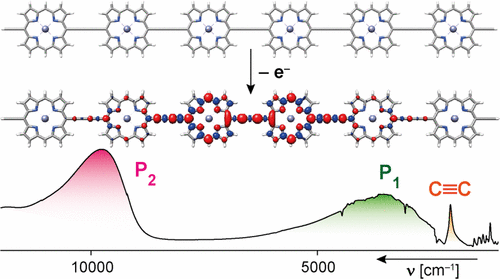当前位置:
X-MOL 学术
›
J. Am. Chem. Soc.
›
论文详情
Our official English website, www.x-mol.net, welcomes your feedback! (Note: you will need to create a separate account there.)
Electronic Delocalization in the Radical Cations of Porphyrin Oligomer Molecular Wires
Journal of the American Chemical Society ( IF 15.0 ) Pub Date : 2017-07-24 00:00:00 , DOI: 10.1021/jacs.7b05386 Martin D. Peeks 1 , Claudia E. Tait 2 , Patrik Neuhaus 1 , Georg M. Fischer 1 , Markus Hoffmann 1 , Renée Haver 1 , Arjen Cnossen 1 , Jeffrey R. Harmer 2 , Christiane R. Timmel 2 , Harry L. Anderson 1
Journal of the American Chemical Society ( IF 15.0 ) Pub Date : 2017-07-24 00:00:00 , DOI: 10.1021/jacs.7b05386 Martin D. Peeks 1 , Claudia E. Tait 2 , Patrik Neuhaus 1 , Georg M. Fischer 1 , Markus Hoffmann 1 , Renée Haver 1 , Arjen Cnossen 1 , Jeffrey R. Harmer 2 , Christiane R. Timmel 2 , Harry L. Anderson 1
Affiliation

|
The radical cations of a family of π-conjugated porphyrin arrays have been investigated: linear chains of N = 1–6 porphyrins, a 6-porphyrin nanoring and a 12-porphyrin nanotube. The radical cations were generated in solution by chemical and electrochemical oxidation, and probed by vis–NIR–IR and EPR spectroscopies. The cations exhibit strong NIR bands at ∼1000 nm and 2000–5000 nm, which shift to longer wavelength with increasing oligomer length. Analysis of the NIR and IR spectra indicates that the polaron is delocalized over 2–3 porphyrin units in the linear oligomers. Some of the IR vibrational bands are strongly intensified on oxidation, and Fano-type antiresonances are observed when activated vibrations overlap with electronic transitions. The solution-phase EPR spectra of the radical cations have Gaussian lineshapes with linewidths proportional to N–0.5, demonstrating that at room temperature the spin hops rapidly over the whole chain on the time scale of the hyperfine coupling (ca. 100 ns). Direct measurement of the hyperfine couplings through electron–nuclear double resonance (ENDOR) in frozen solution (80 K) indicates distribution of the spin over 2–3 porphyrin units for all the oligomers, except the 12-porphyrin nanotube, in which the spin is spread over about 4–6 porphyrins. These experimental studies of linear and cyclic cations give a consistent picture, which is supported by DFT calculations and multiparabolic modeling with a reorganization energy of 1400–2000 cm–1 and coupling of 2000 cm–1 for charge transfer between neighboring sites, placing the system in the Robin–Day class III.
中文翻译:

卟啉低聚物分子线的自由基阳离子中的电子离域
已经研究了π共轭卟啉阵列家族的自由基阳离子:N的线性链= 1-6卟啉,6-卟啉纳米环和12-卟啉纳米管。自由基阳离子是通过化学和电化学氧化在溶液中生成的,并通过vis–NIR–IR和EPR光谱仪进行探测。阳离子在〜1000 nm和2000-5000 nm处显示出很强的NIR谱带,随着低聚物长度的增加,该谱带移至更长的波长。对NIR和IR光谱的分析表明,极化子在线性低聚物中的2-3卟啉单元上是离域的。某些IR振动带在氧化时会强烈增强,并且当激活的振动与电子跃迁重叠时会观察到Fano型反共振。自由基阳离子的溶液相EPR光谱具有高斯线形,线宽与N –0.5成比例,表明在室温下,自旋跃变在超精细耦合的时间尺度(约100 ns)上在整个链上迅速跳动。通过电子核双共振(ENDOR)在冷冻溶液(80 K)中直接测量超精细偶合,表明除12卟啉纳米管外,所有低聚物的自旋分布在2-3个卟啉单元上散布在大约4–6卟啉中。这些线性和环状阳离子的实验研究给出了一致的图像,这得到了DFT计算和多抛物线建模的支持,重组能量为1400–2000 cm –1,耦合为2000 cm –1,用于相邻位点之间的电荷转移,从而使系统在罗宾·戴(Robin-Day)III类中。
更新日期:2017-07-25
中文翻译:

卟啉低聚物分子线的自由基阳离子中的电子离域
已经研究了π共轭卟啉阵列家族的自由基阳离子:N的线性链= 1-6卟啉,6-卟啉纳米环和12-卟啉纳米管。自由基阳离子是通过化学和电化学氧化在溶液中生成的,并通过vis–NIR–IR和EPR光谱仪进行探测。阳离子在〜1000 nm和2000-5000 nm处显示出很强的NIR谱带,随着低聚物长度的增加,该谱带移至更长的波长。对NIR和IR光谱的分析表明,极化子在线性低聚物中的2-3卟啉单元上是离域的。某些IR振动带在氧化时会强烈增强,并且当激活的振动与电子跃迁重叠时会观察到Fano型反共振。自由基阳离子的溶液相EPR光谱具有高斯线形,线宽与N –0.5成比例,表明在室温下,自旋跃变在超精细耦合的时间尺度(约100 ns)上在整个链上迅速跳动。通过电子核双共振(ENDOR)在冷冻溶液(80 K)中直接测量超精细偶合,表明除12卟啉纳米管外,所有低聚物的自旋分布在2-3个卟啉单元上散布在大约4–6卟啉中。这些线性和环状阳离子的实验研究给出了一致的图像,这得到了DFT计算和多抛物线建模的支持,重组能量为1400–2000 cm –1,耦合为2000 cm –1,用于相邻位点之间的电荷转移,从而使系统在罗宾·戴(Robin-Day)III类中。



























 京公网安备 11010802027423号
京公网安备 11010802027423号